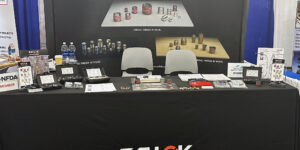SEE THE LIGHT: REINVENTING THE MANUFACTURING INDUSTRY
A Paradigm Shift: Still inspecting the finished part? Think again. New process variation monitoring systems focus on preventing errors ? rather than detecting them after they occur ? by refining and improving the manufacturing process itself.
Posted: November 19, 2009
Imagine . . .
. . . If an operator knew when a production process was unstable and fixed it immediately.
. . . If a machine automatically shut off or alerted someone when there was a setup error.
. . . If an error could be predicted before it even happened.
Every so often a technological breakthrough reinvents the way manufacturing is done. We introduced the assembly line in the early 1900s, which permitted mass production of products at a fraction of the cost. We had the invention of robotics in the mid-20th century, which assured accurate and reliable performance levels at increased speeds. Now we have process monitoring systems, an advanced technology which will again reinvent this age old industry.
Process monitoring systems, technically referred to as Process Variation Monitoring (PVM), represent a true paradigm shift in technology for the manufacturing industry. PVM devices are putting the emphasis on refining and improving the manufacturing process itself ? away from inspecting the finished part with traditional methods. This proactive methodology focuses on preventing errors, rather than detecting them after they occur.
With today?s zero defect tolerance, manufacturers must pay close attention to quality and be sure they do not ship even one ?bad? product to their customer. Doing the latter can result in expensive consequences, such as being put on containment by the customer, a complete product recall, or worst of all, lost future contracts. At the very least, it results in increased costs and a diminished reputation. For these reasons, it is absolutely imperative that defective and sub-standard products do not make it out the door.
MEASURING QUALITY
Until recently, companies had learned to rely solely on post production inspection methods and devices to detect any bad products before they might be shipped. This conventional practice followed the underlying assumption that a defective part can be produced at anytime and that catching these parts before they went out to customers was a priority. Little emphasis, if any, was put on the actual manufacturing process.
With the demand for quality hitting an all time high, progressive companies are shifting their focus by putting less emphasis on the inspection stages and more emphasis on refining and improving the manufacturing process itself. Their conviction is that it is impossible for a good process to produce a bad part, unless something in the process changes.
This revolutionary attitude towards quality assurance is simple: monitor the process. This paradigm shift derives from a basic scientific principle: If all variables in a process are stable and constant, the outcome of the process will remain stable and constant as well.
Monitoring the process and fixing the problem at the source, before additional costs are incurred, is the most progressive way of ensuring quality assurance.
In many force-form manufacturing processes, such as end-forming, tube bending and wire crimping, any time a constant or predicted force is used to modify a part the strain that the machine experiences during that process is directly related to the resistance to that force. The resistance to that force is then any variable in the process and the strain is a measurable outcome of the process.
?When the strain is no longer stable and constant, we know that a variable has changed and that the process is now capable of producing a faulty product? explains Kiet Ngo, director of research and development for OES Technologies (London, ON) and inventor behind U.S. patent #7,216,519 B1, one of seven patents held by OES. The patent proves that a sensitive and stable strain sensor, coupled to an intelligent analysis device, can provide an accurate and reliable indication of process quality.
The ?variables? in a process that might change and affect part quality could be the raw material, broken or worn tooling, machine deterioration, equipment failure, lack of lubrication, or even improper presentation of the raw material. If the ?outcome? is altered, then a variable in the process has to have changed. The task then becomes effectively monitoring the process in order to detect the critical changes (or variations) in that process.
For our North American based Tier 1 manufacturers, the challenge to succeed has grown even greater as foreign competition continues to affect the market in the midst of a slumping economy. This innovative technology allows the continuous improvement of quality through process improvement, while reducing unnecessary costs from scrap material and/or downtime, thus helping this market remain competitive.
Early adopters and followers, such as Centerline (Windsor) Ltd. (Windsor, ON) in welding, are realizing the significance of this technology and focusing on the opportunity, sustainability and profitability that comes with a paradigm shift of this nature. Some OEM companies, such as Addison Mckee Inc. (Lebanon, OH) in tube bending, are quickly supporting this movement by offering PVM products. Others are educating themselves in preparation for the majority acceptance.
When the fluid handling division of one Tier 1 company was experiencing process problems and potentially creating defective parts that may have lead to connection leaks, they deployed an OES monitoring system as a quality solution. The bad parts were being caught, but the cost of scrap material got expensive and solving the problem became critical. As a data driven organization with a strong commitment to operational excellence, finding the process problem and monitoring it thereafter served as a huge cost saver.
Consider an example of mandrel bending. Most bends are designed to be performed with a lubricated mandrel. If the lubrication is not present (automatic lubrication system failure or omission by the operator), it is quite possible that the product produced by the faulty process could continue to meet the acceptable dimensional and visual criteria for a while. After a few or perhaps many bends, the mandrel is likely to break, resulting in downtime for service. At that point it is likely that the lubrication failure will be discovered and then rectified. The pipe in which the mandrel broke would (hopefully!) be identified and isolated, and the production would continue.
But what about those many pipes produced prior to the breakage that were bent with a non-lubricated mandrel? The material in each of those bends was exposed to a far greater amount of strain than the process was designed to exert. Was the material stressed to near the breaking point? Will the affected exhaust pipes last one month, one year, or through the warranty period? This is absolutely the strongest argument for process variation monitoring: even if the part looks good and passes dimensional and visual inspections, it is not necessarily a good part.
Wouldn?t it be more effective to monitor the process and control the variables at the source of production?
PVM products allow the operator to set parameters (or tolerance levels) for deviation from the learned signature. This works to catch bad processes, but gives manufacturers control over their own quality standards. When a part has been made outside the tolerances of a known good process, the operator is alerted to make adjustments, and the situation is rectified well before a real problem occurs.
In a force forming application, something in the process may change to the point that it is detectable, but still minor, and the process might still be producing good parts ? but only for awhile. Sooner or later (and most likely sooner), the process will either produce a defective part or it will cause damage to the tooling or machine. With PVM technology, you now have an early warning system that alerts you of these conditions.
THE FUTURE OF QUALITY ASSURANCE
With stringent controls being placed on product quality in the automotive industry, it is increasingly likely that production standards will require PVM technology. Process variation monitoring is a more efficient, more reliable, more advanced, and more practical solution. The manufacturing industry shouldn?t settle for mediocrity and chance unexpected costs anymore . . . because every so often a technological innovation reinvents the way we do business.
– – – – – – – – – – – – – – – – – – – – – – – – – – – – – – – – – – – – – – – – –
Paul Hogendoorn is the president and co-founder of OES Inc., 4056 Blakie Road, London, Ontario N6L 1P7, Canada, 519-652-5833, Fax: 519-652-3795, www.OEStechnologies.com , phogendoorn@oes-inc.com .









